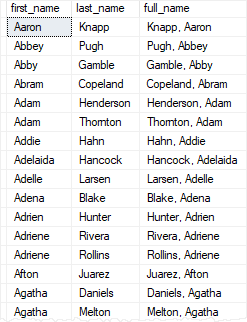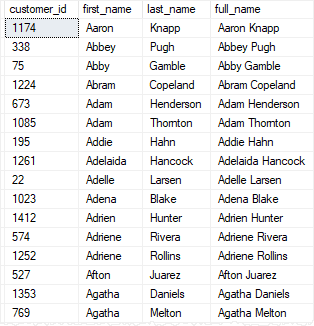
Thanks for stopping by and see you in the next post. Therefore, the best solution for this kind of situation is SQL CLR! Īpparently our winner was FOR XML PATH, but if we are going to analyze the results, the CLR delivered the correct result, even with all this nonsense rows:įOR XML PATH… It ended up getting lost and the results were not in the correct order. I even went to lunch and left running here, but after 2 hours and 22 minutes I couldn't wait to finish processing the 158 thousand lines (remembering that the CLR processed 850.000 in 3s and FOR XML in 1.5s). Well, I tried to wait for the Recursive CTE. 5.7s to 158.000 lines is a reasonable time.
SQL SERVER CONCAT UPDATE
Until the time with UPDATE wasn't too bad. Since no other method was able to finish processing in less than 1 minute, although I used 850.000 lines with the CLR and FOR XML PATH, I will only use 158.000 lines (27%) for the rest of the methods to try to parse the results. What happens if we insert more records? Like some 850.000 lines. Right away we can eliminate the loopings, which were much worse. Let's now measure our solutions and find out which ones are the fastest and the slowest.
SQL SERVER CONCAT HOW TO
Not sure what CLR is or know, but not sure how to implement it in your database? Learn more by visiting my post Introduction to SQL Common Language Runtime (CLR) in SQL Server. Practical, extremely fast, generic and solves our problem. Void IBinarySerialize.Write(System.IO.BinaryWriter w) CONCAT function in SQL Server 2012 allows TEXT types to be joined, but theSQL Server 2008 R2 and earlier versions using the + method does not from my experience. If (_accumulator.Length != 0) this.IsNull = false _accumulator = new StringBuilder(r.ReadString()) Void IBinarySerialize.Read(System.IO.BinaryReader r) Return new SqlString(_accumulator.ToString()) _accumulator.Append(Group._accumulator.ToString()) & Group._accumulator.Length > 0) _accumulator.Append(_delimiter) Public void Accumulate(SqlString Value, SqlString Delimiter) Public struct concat : IBinarySerialize, INullable UPDATE Descricoes += ', ' + ISNULL(Categoria, '') = '') If an illegal character is found, then reject the value, and exit without executing any SQL.GROUP INT = INT = (SELECT COUNT(*) FROM <= ISNULL(Categoria, = BY

check for any characters not in those ranges using LIKE '%%'. One way to address this vulnerability is to validate the contents of say it should contain only alphabetic and numeric characters (e.g. (The first attacks can be attempts to retreive information about tables and columns, followed by attempts to retrieve data (email addresses, account numbers, etc.)

Any SQL could be injected, and it might be much more subtle and even more nefarious.


When we EXECUTE that string as a SQL statement: INSERT INTO SELECT 1 AS foo Īnd it's not just a DROP TABLE that could be injected. The string we would produce as a SQL statement would be: 'INSERT INTO SELECT 1 AS foo DROP TABLE students - AS fld1. The old-school sp_executesql procedure is an alternative to EXEC, another way to execute dymamic SQL, which also allows you to pass parameters, rather than specifying all values as literals in the text of the statement.ĮBarr points out (correctly and importantly) that this approach is susceptible to SQL Injection.Ĭonsider what would happen if contained the string: '1 AS foo DROP TABLE students - ' But we can execute the contents of the string, as a dynamic SQL statement, using EXECUTE (or EXEC for short). Given a of 'Foo', that would create a string containing: 'INSERT INTO SELECT Foo AS fld1 FROM tblFoo'Īt this point, it's just a string. So you can use something like this approach: SET = 'INSERT INTO SELECT ' + ' AS fld1 FROM tbl' + we create a SQL statement as a string. The table references and column references can't be supplied as parameters, those have to appear in the SQL text. That's because the tablename has to specified in the actual SQL text, when you execute the statement. The trick is that you need to create a string containing the SQL statement. You can accomplish this (if I understand what you are trying to do) using dynamic SQL.


 0 kommentar(er)
0 kommentar(er)
